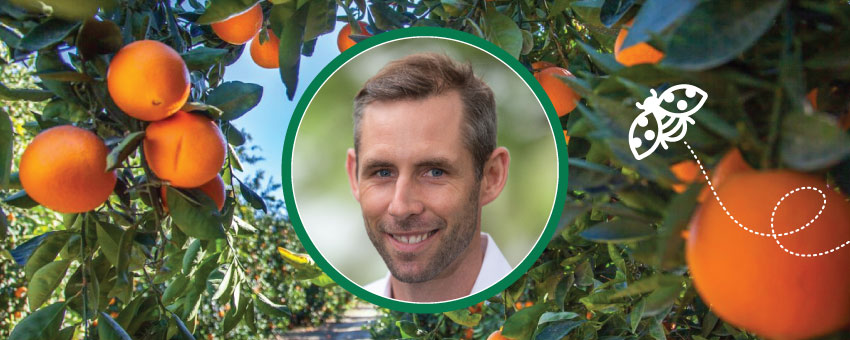Using Citrus as an example: Phytophthora spp. cause root rot, brown rot and gummosis while Alternaria spp. cause navel end rot and brown spot. The management of these diseases is essential to maintaining tree health and optimising yields. It is also essential to limit infection rates so that fruit quality is maintained for as long as possible after harvesting. The hard part is the timing of fungicide applications to effectively target these pathogens. If timing of sprays is off due to unforeseen environmental conditions that promote fungal growth, the battle could be lost and money would be wasted on mistimed fungicide sprays. In addition, Alternaria resistance to Strobilurins is already widespread in certain parts of the world. Thus it is essential that we follow an integrated approach to managing resistance (Dewdney 2013).
Asanzi et al. (2015) proved that root applied potassium silicate can reduce Alternaria alternata disease severity by ±50% compared to a control sample in leaves on Mandarin. This was after only 3 treatments, one month apart. What is important here is that silica strengthens the cell walls physically, making pathogen entry more difficult (Fawe et al. 2001) but also stimulates the plant’s natural defence pathways physiologically, essentially strengthening the immune system (Wang et al. 2017). A great example is given by Fawe et al. (2001) who showed that in cucumber, silica applications stimulated proteins that enabled soluble silica to be converted into SiO2 that was then deposited directly in leaves where diseases were trying to penetrate the outer layer of cells. In simple terms, the plant recognised a potential threat (fungal pathogen) and laid down a protective silicon layer to stop entry of the threat. This protective silicon-based layer has also been shown to reduce feeding of probing and sucking insects (Currie et al. 2007). In fact, soil applications of Andermatt Madumbi’s AgriSil K50 (potassium silicate) in the Mossel Bay area have significantly reduced leaf miner damage compared to an untreated block.
So what does it all mean?
Applying plant available silicon – for example AgriSil K50 – as a regular input to the roots of plants has several benefits:
- increase growth and plant vigour;
- increase resistance to foliar and root-based diseases;
- increase resistance to sucking and chewing pests;
- and increase physiological ability to deal with stress (eg. wind, heat, severe cold).
Furthermore, a review by Mvondo-she et al. (2021) highlighted that potassium silicate applications can also improve the shelf-life of citrus fruits by limiting post-harvest disease symptoms of Green and Blue mould (Penicilium spp.).
Stay in touch with us, as we are busy with in-field trials to further substantiate just how great an addition AgriSil K50 can be in your IPM programme.
Citations
Asanzi, N.M.; Taylor, N.J.; Vahrmeijer, J.T. Can silicon be used to prevent Alternaria alternata in citrus trees? Technologie. 2015, 48, 1–3.
Dewdney, M. Alternaria Brown Spot. PP152. Plant Pathology Department, Florida Cooperative Extension Service, Institute of Food and Agricultural Sciences, University of Florida. 2013.
Currie, H.A.; Perry, C.C. Silica in plants: Biological, biochemical and chemical studies. Annals of Botany. 2007, 100, 1383–1389.
Fauteux, F.; Remus-Borel,W.; Menzies, J.G.; Belanger, R.R. Silicon and plant disease resistance against pathogenic fungi. FEMs Microbiology Letters. 2005, 249, 1–6.
Fawe, A.; Menzies, J.G.; Chérif, M.; Bélanger, R.R. Silicon and disease resistance in dicotyledons. Plant Science. 2001, 8, 159–169.
Liang, Y.; Sun,W.; Zhu, Y.-G.; Christie, P. Mechanisms of silicon-mediated alleviation of abiotic stresses in higher plants: A review. Environmental Pollution. 2007, 147, 422–428.
Meena, V.D.; Dotaniya, M.L.; Coumar, V.; Rajendiran, S.; Kundu, A.S.; Rao, A.S. A case for silicon fertilization to improve crop yields in tropical soils. Proceedings of the National Academy of Sciences India Section B – Biological Sciences. 2014, 84, 505–518.
Mvondo-She, M.A.; Gatabazi, A.; Laing, M.D.; Ndhlala, A.R. A Review on the Role of Silicon Treatment in Biotic Stress Mitigation and Citrus Production. Agronomy. 2021, 11, 2198. https://doi.org/10.3390/agronomy11112198.
Wang, M.; Gao, L.; Dong, S.; Sun, Y.; Shen, Q.; Guo, S. Role of Silicon on Plant–Pathogen Interactions. Frontiers of Plant Science. 2017, 8, 701.
Wanneer ons Sitrus as voorbeeld gebruik: Phytophthora spp. veroorsaak wortelvrot, bruinvrot en gummosis (gom vorming) terwyl Alternaria spp. nawel-endverrotting / swartkernverrotting en bruinvlek veroorsaak. Die bestuur van hierdie siektes is noodsaaklik om boomgesondheid te handhaaf en opbrengste te optimaliseer. Dit is ook noodsaaklik om besmettingsvlakke te beperk sodat vrugkwaliteit so lank as moontlik na oes behoue bly. Die moeilike deel is die tydsberekening van swamdodertoedienings om hierdie patogene effektief te teiken. As tydsberekening van bespuitings uit is as gevolg van onvoorsiene omgewingstoestande wat swamgroei bevorder, kan die stryd verlore wees en geld word gemors op ontydige swamdoderbespuitings. Daarbenewens kom Alternaria-weerstand teen Strobiluriene reeds wydverspreid in sekere dele van die wêreld voor. Dit is dus noodsaaklik dat ons ‘n geïntegreerde benadering volg om weerstand opbou te bestuur (Dewdney 2013).
Asanzi et al. (2015) het bewys dat worteltoegediende kaliumsilikaat die ergheidsgraad van Alternaria alternata simptome met ±50% kan verminder in vergelyking met ‘n onbehandelde kontrole in Mandaryn blare na slegs 3 behandelings, een maand uitmekaar. Wat hier belangrik is, is dat silika die selwande fisies versterk, wat die indringing van die patogeen moeiliker maak (Fawe et al. 2001), maar ook die plant se natuurlike verdedigingsmeganismes fisiologies stimuleer, wat in wese die immuunstelsel versterk (Wang et al. 2017).
‘n Goeie voorbeeld word gegee deur Fawe et al. (2001) wat getoon het dat silikatoedienings op komkommers proteïene stimuleer wat oplosbare silika in SiO2 omskakel, wat dan direk in blare neergelê is waar patogene die buitenste laag selle probeer binnedring. In eenvoudige terme het die plant ‘n potensiële bedreiging (swampatogeen) herken en ‘n beskermende silikonlaag neergelê om die patogeen indringing te keer. Daar is ook getoon dat hierdie beskermende silikon-gebaseerde laag die voeding van steek-suigende insekte verminder (Currie et al. 2007). Om die waarheid te sê, grondtoedienings van Andermatt Madumbi se AgriSil K50 (kaliumsilikaat) in die Mosselbaai-omgewing het blaarmynerskade aansienlik verminder in vergelyking met ’n onbehandelde blok.
So wat beteken dit alles?
Die gereelde toediening van plantbeskikbare silikon – byvoorbeeld AgriSil K50 – op die wortels van plante hou verskeie voordele in:
- i) groei en plantlewenskragtigheid verhoog;
- ii) weerstand teen blaar- en wortelsiektes verhoog;
iii) verhoog weerstand teen suigende en kouende plae;
- iv) en verhoog fisiologiese vermoë om stres te hanteer (bv. wind, hitte, erge koue).
Verder het ‘n resensie deur Mvondo-she et al. (2021) uitgelig dat kaliumsilikaat-toedienings ook die raklewe van sitrusvrugte kan verbeter deur na-oes siektesimptome van groen- en blouskimmel (Penicilium spp.) te beperk.
Bly in kontak met ons, want ons is besig met proewe in die veld om verder te staaf hoe groot ‘n byvoeging AgriSil K50 in jou IPM-program kan wees.
Aanhalings
Asanzi, N.M.; Taylor, N.J.; Vahrmeijer, J.T. Can silicon be used to prevent Alternaria alternata in citrus trees? Technologie. 2015, 48, 1–3.
Dewdney, M. Alternaria Brown Spot. PP152. Plant Pathology Department, Florida Cooperative Extension Service, Institute of Food and Agricultural Sciences, University of Florida. 2013.
Currie, H.A.; Perry, C.C. Silica in plants: Biological, biochemical and chemical studies. Annals of Botany. 2007, 100, 1383–1389.
Fauteux, F.; Remus-Borel,W.; Menzies, J.G.; Belanger, R.R. Silicon and plant disease resistance against pathogenic fungi. FEMs Microbiology Letters. 2005, 249, 1–6.
Fawe, A.; Menzies, J.G.; Chérif, M.; Bélanger, R.R. Silicon and disease resistance in dicotyledons. Plant Science. 2001, 8, 159–169.
Liang, Y.; Sun,W.; Zhu, Y.-G.; Christie, P. Mechanisms of silicon-mediated alleviation of abiotic stresses in higher plants: A review. Environmental Pollution. 2007, 147, 422–428.
Meena, V.D.; Dotaniya, M.L.; Coumar, V.; Rajendiran, S.; Kundu, A.S.; Rao, A.S. A case for silicon fertilization to improve crop yields in tropical soils. Proceedings of the National Academy of Sciences India Section B – Biological Sciences. 2014, 84, 505–518.
Mvondo-She, M.A.; Gatabazi, A.; Laing, M.D.; Ndhlala, A.R. A Review on the Role of Silicon Treatment in Biotic Stress Mitigation and Citrus Production. Agronomy. 2021, 11, 2198. https://doi.org/10.3390/agronomy11112198.
Wang, M.; Gao, L.; Dong, S.; Sun, Y.; Shen, Q.; Guo, S. Role of Silicon on Plant–Pathogen Interactions. Frontiers of Plant Science. 2017, 8, 701.

